Are Flexible Workspaces the Future for Americans in the Next Decade?
According to Statista, In 2017, there were 542,000 people working in coworking spaces in the U.S., forecasted to increase to about 1.08 million in 2022.
How would you define a workspace? A fixed cubicle, a static environment where employees arrive at the same spot every day to perform almost the same routine work. That’s how most of the working population in the US or anywhere in the world knows it. Well, at least until the 1990s. Despite having different functional departments, these companies chose to operate their workspace with a one-size-fits-all approach.
The answer to a growing office was to add more desks in the same cubicle to make space for a new employee. It played a major role in transforming professional and personal lives, often dramatically. The truth is, it’s not hard to understand that employees/workers were both a great asset but also an expense.. Yet, companies could not offer workers flexible work solutions and paid the least attention to their experiences and emotional well-being.
Fast forward to 2020, the modern workforce is mobile in nature and considering this, it has become important for employers to think outside the ‘cubicle’. The change has pervaded all facets of today’s workplace. Space solutions are now varied to accommodate a vast set of needs while also being able to change rapidly.
Times have changed and so have the pressures in the ever-competitive corporate life. Apart from logging long hours in the office, external factors like traffic, pollution, etc are adding to employee stress. Management realizes that today’s workplace should reflect the needs of the organization as well as its people. A productive, motivated team is what every organization wants.
Coworking, as well as other viable flexible workspaces are placing less focus on privacy, instead, offering conducive environments for people to innovate, collaborate and be more productive. Such workplaces have become stepping stones of the human approach to design, a trend which is a motivation for companies and real estate developers. Growing statistics show proof of that:
- There are approximately over 35,000 flexible workspaces in the entire world which represents 521 million sq. feet of flexible space.
- The global market value of flexible workspaces is estimated at approximately $26 billion.
- Up until 2022, the number of coworking spaces is expected to grow at an annual rate of 6% in the U.S and 13% elsewhere.
- The amount of coworking space leased and its share of total office space rose by almost half in only 18 months from the end of 2016 through mid-2018.
(All Work Space 2019)
The availability of smart technologies and modern resources have also propelled a rapid change in workspace construction. The ergonomic design of a modern office space blends smoothly in setting up a professional yet comfortable experience-based workspace.
Mobility also plays a decisive role in creating a modern workplace environment. Mobility sometimes requires more unassigned or touchdown space for those who are usually out of the office – say, salespeople, field service technicians, international employees who travel to Houston or who need to come back at times to connect and collaborate live.
So, how does a company decide which category of workspace solution is right for its employees? We suggest connecting with a real estate expert or a workplace strategist who can help you take your first step. Oliver CRE specializes in identifying the unique workflow of your company and accordingly, tailoring the office environment to meet the specific needs of each individual.
We Can Find That Perfect Productivity Solution for Your Company
Oliver CRE is a young, aggressive, thoughtful and well-connected brokerage firm. We offer tenant management and tenant representation services to ease property owner burdens of property management.
We’re approachable, ready to act and get your organization the right solution at the right time, in the right place.
Works Cited
Mazareanu, E. “Coworking Spaces: Number of Members U.S. 2022.” Statista, 13 Jan. 2020, www.statista.com/statistics/797564/number-of-people-working-in-coworking-spaces-us/).
“Coworking Is The New Normal, And These Stats Prove It.” AllWork.Space, 10 May 2019, allwork.space/2019/05/coworking-is-the-new-normal-and-these-stats-prove-itt/.



